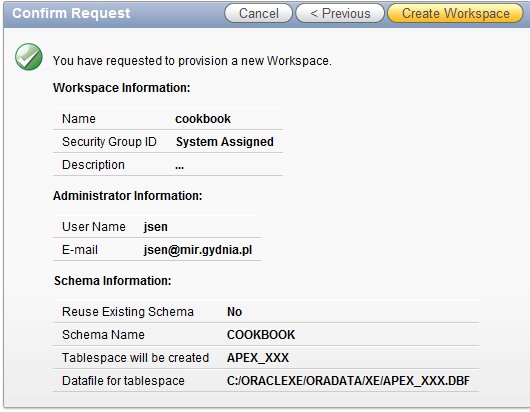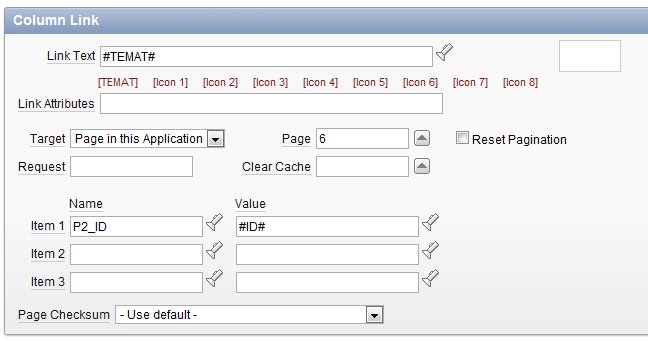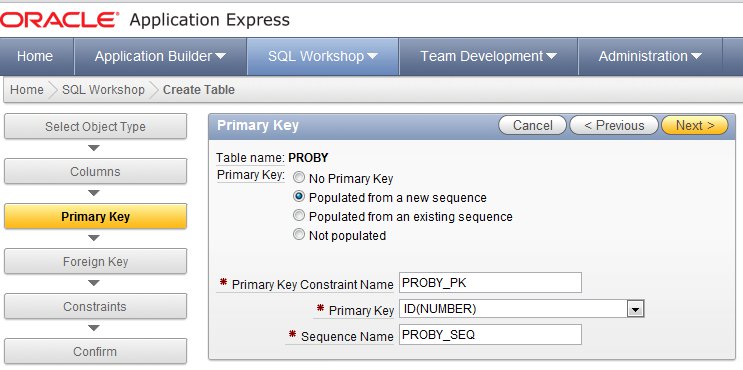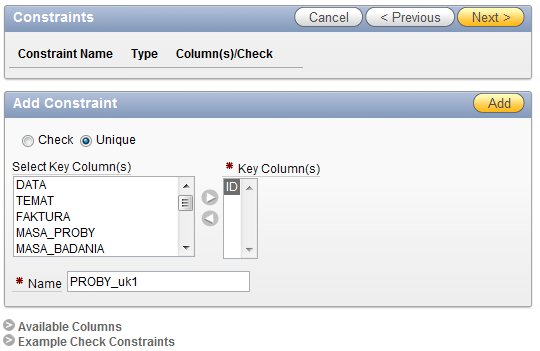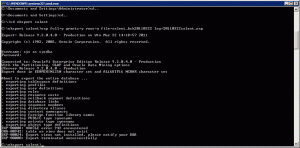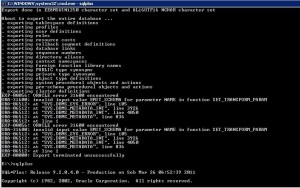27 kwietnia 2011
…
22 kwietnia 2011
ApEx
Grupy w APEXie
http://www.avout.com/avout-blog/using-groups-application-express
REST services
http://docs.oracle.com/cd/E37099_01/doc/doc.20/e25066/toc.htm
JavaScritp Apex
https://apex.oracle.com/pls/apex/f?p=31517
APEX installation
http://docs.oracle.com/cd/E37097_01/doc/install.42/e35123/toc.htm
Creating new workspace and assigning a schema to it.
(K1)
Oracle OLTP features.
Nonescalating row-level locking
Multiversion read consistency - Oracle provides statement-level and transaction-level data consistency withoutrequiring read locks. Oracle uses rollback segments toreproduce data as it existed at the time the query started.
Shared SQL - The parsing of a SQL statement is fairly CPU-intensive. Oracle caches parsedand optimized SQL statements in the shared SQL area within the shared pool.
Bind Variables and Shared SQL
Oracle’s shared SQL is a key feature for building high-performanceapplications. In an OLTP application, similar SQL statements may be used repeatedly,but each SQL statement submitted will have different selection criteria contained in theWHERE clause to identify the different sets of rows on which to operate. Oracle canshare SQL statements, but the statements must be absolutely identical.To take advantage of this feature for statements that are identical except for specificvalues in a WHERE clause, you can use bind variables in your SQL statements. Thevalues substituted for the bind variables in the SQL statement may be different, but thestatement itself is the same.
Youcan write the application to use bind variables
UPDATE emp SET salary = salary * (1 + :v_incr)
WHERE empno = :v_empno;
Stored outlines - The route a SQL statement takes during executionis critical for high performance. Once application developers and DBAshave tuned a SQL statement for maximum efficiency, they can force the Oracleoptimizer to use the same execution plan regardless of environmental changes.
Multi-Threaded Server/shared server – allow Oracle to support larger user populations.
Database Resource Manager - The DRM allocates CPU and parallelism resources to consumer groups based on resource plans. For example, you can allocate 80 percent of the CPU resources to order-entry users, with the remaining 20 percent allocated to users asking for reports. If the order-entry users aren’t using all the allocated resources, the reporting users can use more than their allotted percentage. With the DRM, you can dynamically alter the details of the plan without shutting down the instance. Oracle9i also added to the Database Resource Manager the ability to proactively estimate the amount of CPU that an operation will require. If an operation looks as if it will exceed the maximum CPU time specified for a resource group, the operation will not be executed, which can prevent inappropriately large operations from even starting.
The DRM now allows a DBA to specify the number of active sessions availableto a consumer group.
Real Application Clusters (235)
21 kwietnia 2011
Kobiety i mężczyźni … cała prawda :-)
20 kwietnia 2011
(K1)
The I/O performed by most OLTP systems tends to beapproximately 70–80 percent read and 20–30 percent write.
Business intelligence data warehousing systems and OLTP systems could accessmuch of the same data, but these types of systems also typically have differentrequirements in terms of CPU, memory, and data layout, which makes supporting amixed workload less than optimal for both types of processing.
Real ApplicationClusters, with dynamic service provisioning since Oracle Database 10g, makes it possibleto allocate individual nodes for individual workloads.
Oracle7 introduced stored procedures written in PL/SQL, Oracle’s proprietary languagefor writing application logic. These procedures are stored in the database andexecuted by clients issuing remote procedure calls (RPCs) as opposed to executingSQL statements. Instead of issuing multiple SQL calls, occasionally with intermediatelogic to accomplish a task, the client issues one procedure call, passing in therequired parameters. The database executes all the required SQL and logic using theparameters it receives.
If the database server failswhile executing some transaction, the application server can resubmit the transactionto a surviving database server, as control of the transaction lies with theapplication server.
net use
net use
Ponieważ głupi windows nie potrafi połączyć się z dwom udziałami jako różni użytkownicy, a w dodatku czasami (zależy od siły i kierunku wiatru) nie pokazuje wszystkich zamontowanych udziałów, to trzeba wykonać:
net use \\serwer\udział /delete
dbverify
dbverify
dbv file=USER01.DBF blocksize=8192
select status from v$datafile;
select status from dba_tablespaces;
recover datafile 9;
przeniesienie pliku
shutdown immediate;
cp plik do nowej lokalizacji
startup mount
alter database rename file ‘sfasfaf’ to ‘fasdfas ‘
alter database open
alter tablespace USERS add datafile ‘f:fsdfs\dsafas.dbf’ size=1024M autoextend=0n;
15 kwietnia 2011
…
Piotr Rubik -- Niech mówią że to nie jest miłość
U2 -- One
Bruno Mars -- Grenade
Bruno Mars -- Just the way you are
11 kwietnia 2011
6 kwietnia 2011
PL/SQL – select into
SQL> declare
2 v_authName author.author_last_name%type;
3 begin
4 select
5 author_last_name into v_authName
6 from
7 author
8 where
9 author_key = ‘A103′;
10
11 dbms_output.put_line(‘Name: ‘||v_authName);
12 end;
13 /
SQL> declare
2 v_author author%rowtype;
3 begin
4 select
5 * into v_author
6 from
7 author
8 where
9 author_key = ‘A103′;
10
11 dbms_output.put_line(‘Name: ’||v_author.author_first_name||’ ‘|| v_author.author_last_name);
12 end;
13 /
Źródła:
http://www.dba-oracle.com/t_pl_sql_plsql_select_into_clause.htm
5 kwietnia 2011
4 kwietnia 2011
Dafault value (alter table – oracle)
alter table PROBY modify (“WYDANO” FLOAT(126) DEFAULT 0)
1 kwietnia 2011
ApEx – primary key
CREATE table “PROBY” (
“ID” NUMBER(7) NOT NULL,
“DATA” DATE,
“TEMAT” VARCHAR2(250),
“FAKTURA” VARCHAR2(200),
“MASA_PROBY” NUMBER(7),
“MASA_BADANIA” NUMBER(7),
“MASA_PO_BADANIACH” NUMBER(7),
“W_ZAMRAZARCE” NUMBER(7),
“DLA_PRACOWNIKOW” NUMBER(7),
“WARTOSC” NUMBER(7),
“WARTOSC_PO_BADANIACH” NUMBER(7),
“ODPADY” NUMBER(7),
“ODPOWIEDZIALNY” VARCHAR2(150),
constraint ”PROBY_PK” primary key (“ID”)
)
/
CREATE sequence “PROBY_SEQ”
/
CREATE trigger “BI_PROBY”
before insert on “PROBY”
for each row
begin
if :NEW.”ID” is null then
select “PROBY_SEQ”.nextval into :NEW.”ID” from dual;
end if;
end;
/
alter table “PROBY” add
constraint “PROBY_UK1″
unique (“ID”)
/
Aby zmienić home page:
Go to shared component.
Click on Edit Security Attribute under Secuirty
In Home Link text box… you will find something smilar to f?p=&APP_ID.:1:&SESSION.
After &APP_ID. you see a number , that number denotes home page.. in the above example 1 denotes the home page change 1 to 4 if you want page 4 to be ur home page
Oracle on VMware
Źródła
http://www.vmware.com/solutions/partners/alliances/oracle-database.html
http://www.vmware.com/solutions/partners/alliances/oracle-vmware-support.html
EXP-00008: Oracle error 942 encountered
EXP-00008: Oracle error 942 encountered
ORA-00942: table or view does not exist
EXP-00024: Export views not installed, please notify your DBA
EXP-00000: Export terminated unsuccessfully
Run the $oracle_home/rdbms/admin/catexp.sql script as sysdba
EXP-00056: Oracle error 31600 encountered
ORA-31600: invalid input value EMIT_SCHEMA for parameter NAME in function SET_TRANSFORM_PARAM
ORA-06512: at “SYS.DBMS_SYS_ERROR”, line 105
It appears that the Postinstall Actions were not completed after the 9.2.0.4 patch set was applied.
So the solution is:
1) Cleanly shutdown the database.
2) Connect to the database using the SYS/password as SYSDBA account.
3) Startup the database using command:
STARTUP MIGRATE <<< This starts up the database in restricted mode.
4) Run the catpatch.sql script from the $ORACLE_HOME\rdbms\admin directory.
5) Cleanly shutdown the database.
6) Startup the database with the command:
STARTUP
7) Perform another export of the database.
Źródła:
http://www.dbasupport.com/forums/archive/index.php/t-42811.html
602 – Diskette Boot Record Error
Compaq Proliant ML 350
błąd: 602 – Diskette Boot Record Error
Przyczyną jest podłączony dysk USB
Źródła:





